Review by Markus Stamm, published August 2021
Table of Contents
Introduction
85mm is a focal length very popular for portrait photography. Typically, very fast lenses are used for that purpose (f/1.4 or even faster), because they have a reputation of offering the smoothest bokeh and the most appropriate skin tone rendering. Unfortunately, those lenses are usually fairly big, heavy and most of all expensive.
Luckily, there are alternatives, both in terms of lenses and also, what to shoot with a moderate tele prime. Not everyone needs a special portrait lens (some maybe don’t even shoot portraits at all). With the AF-S 85/1.8 G, Nikon offers such a more affordable and budget-friendly alternative for mainstream clients and purposes.
The lens offers most of the technical standards of the late F mount era, especially a silent-wave AF drive, which makes it compatible with the complete range of current Nikon DSLRs.
In this review we take a look at how the lens performs on our 45 MP review camera, the Nikon D850. We also reviewed the lens on the Nikon D3x back in 2012, so if you’re interested in how the lens performs on a lower resolution FX body, please have a look here. For obvious reasons, parts of the earlier review have been reused here.
The build quality of the lens is very decent thanks to an outer barrel made out of high quality plastics. It’s the same material used on most recently released consumer primes, in fact the lens looks and feels like a scaled up variant of an AF-S 50mm.
The rubberized focus ring is nicely damped and operates smoothly. We’re glad to report that the focus unit follows the focus ring immediately and without any delay, even when changing the focus direction.
Thanks to an IF (inner focus) design the length remains constant regardless of the focus setting and the front element does not rotate. Using a polarizer is therefore no problem.
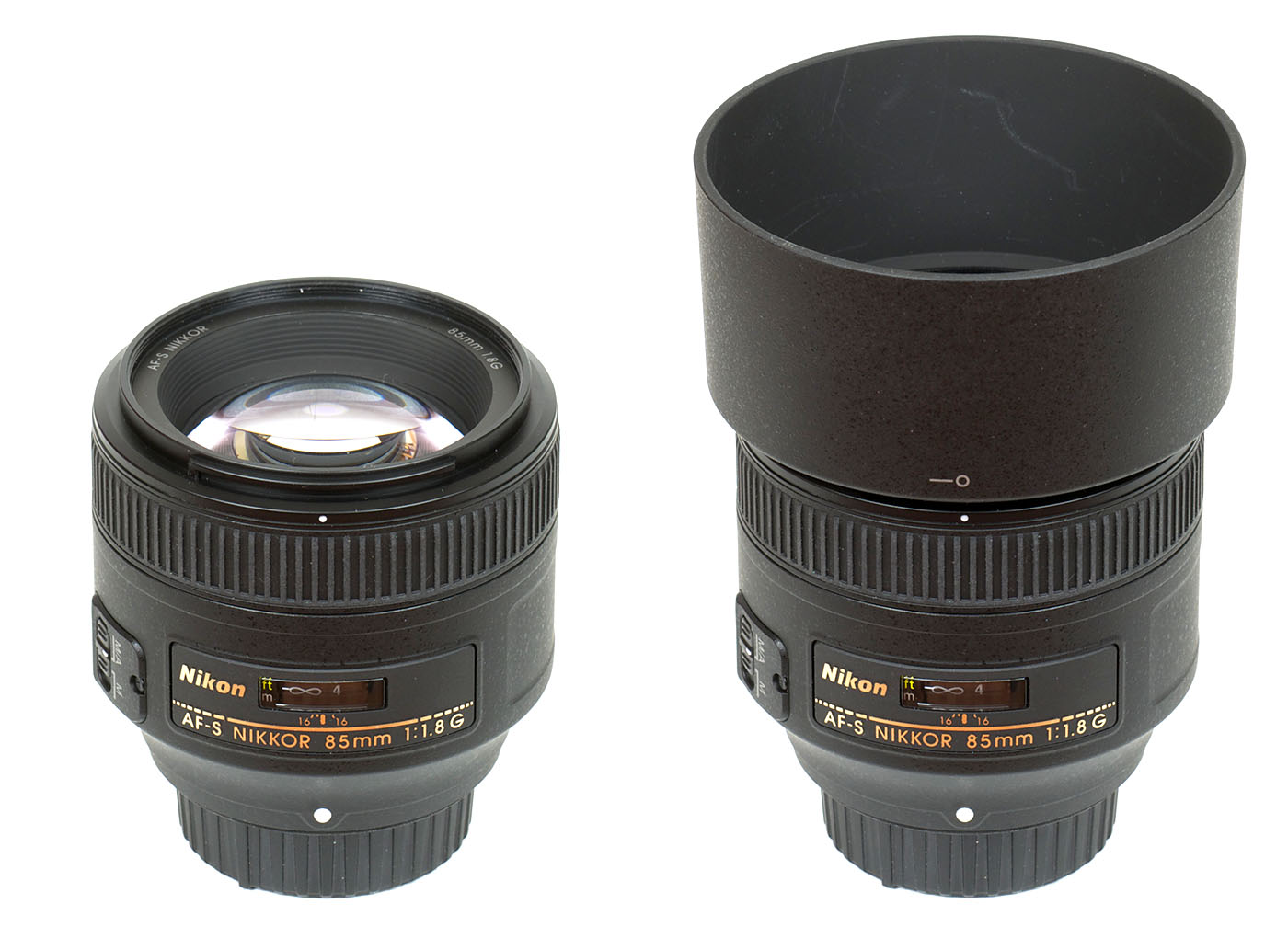
The lens features a Silent Wave ultrasonic drive allowing for a near-silent autofocus and manual override at all times. The AF speed is quite fast for a portrait prime, but still slower than the high-end f/2.8 professional zooms.
The AF-S 85 is a G-type lens and thus does not offer an aperture ring.
| Specifications | |
|---|---|
| Optical construction | 9 elements in 9 groups |
| Number of aperture blades | 7 (rounded) |
| min. focus distance | 0.8 m (max. magnification ratio 1:8) |
| Dimensions | 80 x 73 mm |
| Weight | 350 g |
| Filter size | 67 mm (non-rotating) |
| Hood | Nikon HB-62, barrel-shaped (bayonet mount, supplied) |
| Other features | Lens provides distance (D) information to the camera, Silent Wave AF motor |
Distortion
The lens shows a very small amount of pincushion distortion that is hardly field-relevant.
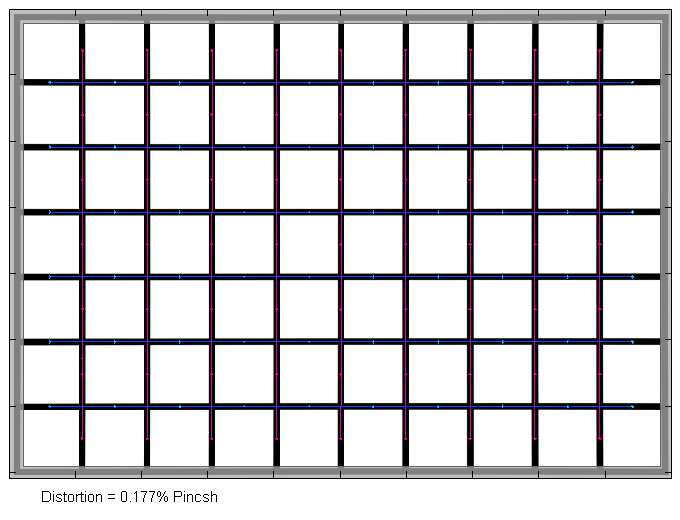
Vignetting
Typical for fast primes, the AF-S 85 shows a significant amount of vignetting wide open. Stopped down the issue is reduced considerably. From f/4 onwards the light fall-off towards the corners should no longer be a problem even for critical subjects.
Please note that the vignetting results are not directly comparable with numbers in our earlier FX reviews based on the Nikon D3x. The JPG engine of the Nikon D3x featured a rather flat gradation curve, thus had a moderate contrast characteristic, resulting in comparatively low vignetting figures – the corresponding figures of other Nikon (and other brands) bodies are considerably higher due to the more aggressive default contrast setting.
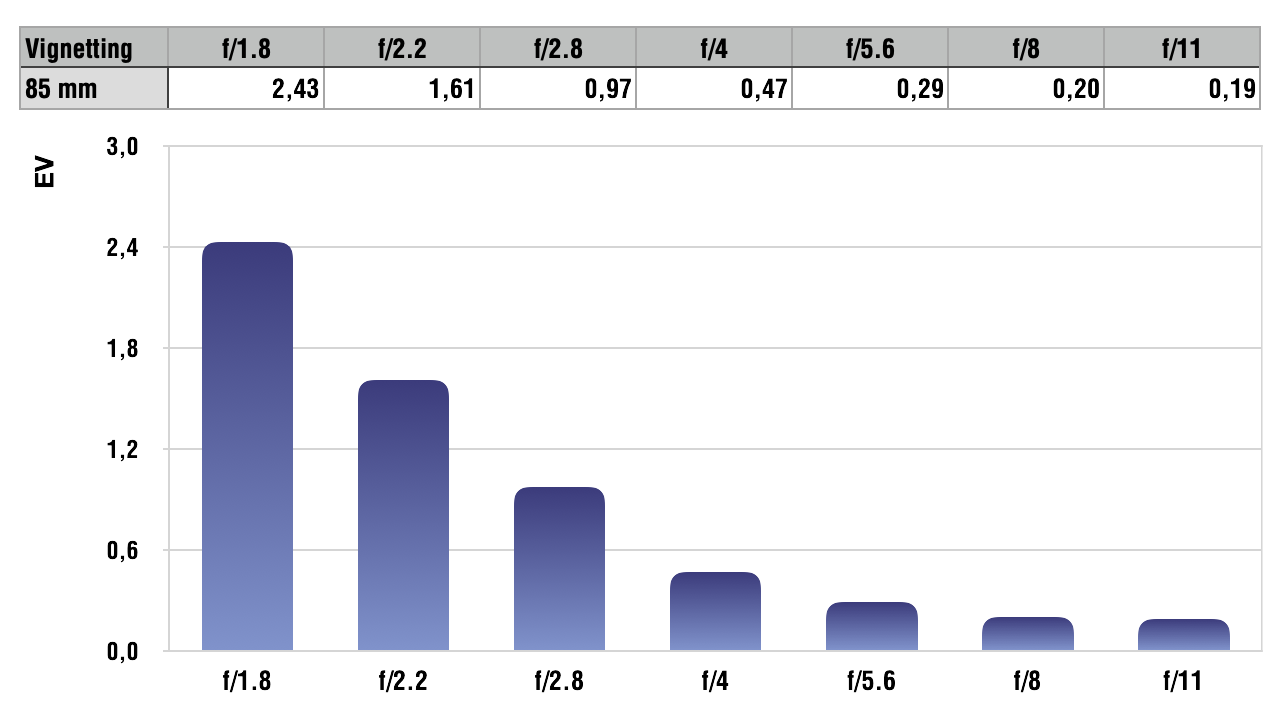
MTF (resolution)
On the D850, the lens delivers very good resolution in the image center wide open. The resolution increases to excellent when stopped down to f/2.8 and stays on a very high level, until diffraction takes its toll at small aperture settings.
Borders and corners offer very good resolution at all tested apertures, with the borders just scratching excellent level at medium aperture settings.
The lens showed a small amount focus shift when stopping down (residual spherical aberration).
Please note that the MTF results are not directly comparable across the different systems!
Below is a simplified summary of the formal findings. The chart shows line widths per picture height (LW/PH) which can be taken as a measure for sharpness. If you want to know more about the MTF50 figures you may check out the corresponding Imatest Explanations

Chromatic Aberrations (CAs)
Chromatic aberrations (color shadows at harsh contrast transitions) are well controlled with an amount of almost 1 pixel at the image borders wide open down to just below 0.7 pixels stopped down.
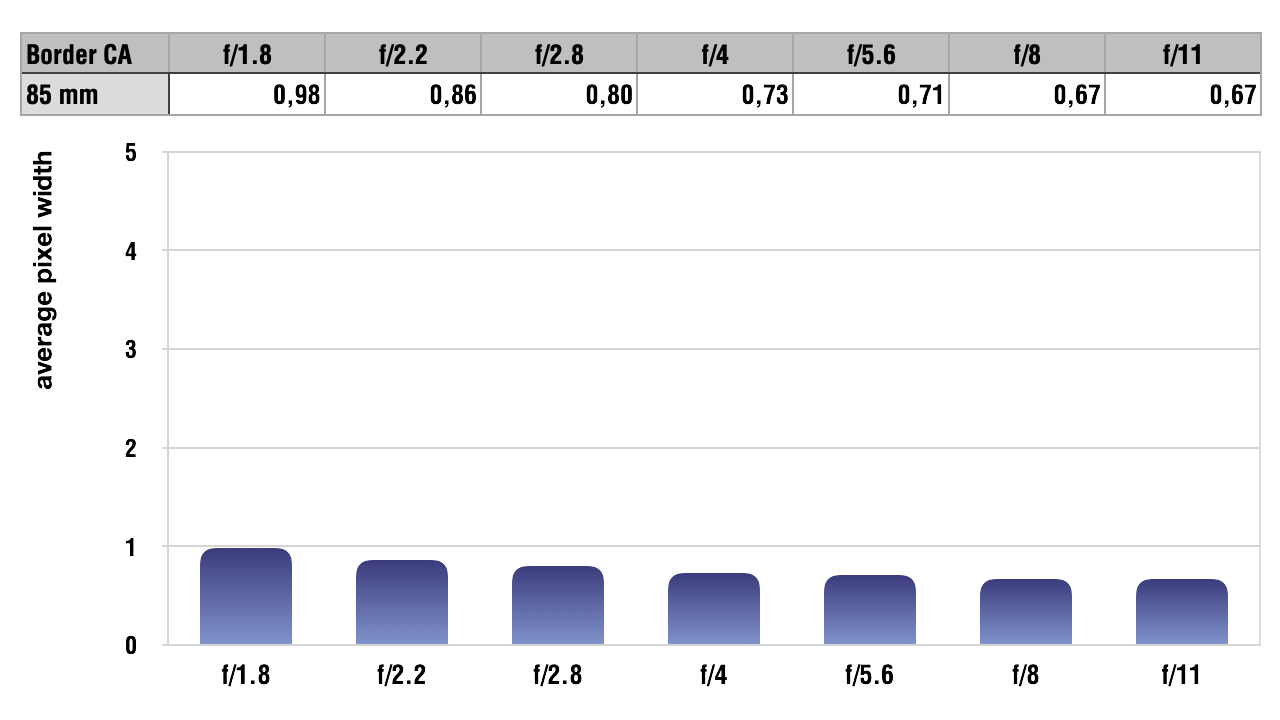
Bokeh
One of the primary usage scenarios for a large aperture lens is to seperate the main subject from the background. In such an image the quality of the bokeh (out-of-focus blur) is of major significance.
The lens produces quite smooth background blur.
Background highlights are evenly filled and show only a tiny amount of outlining at the border. However, there are visible traces of bokeh fringing around highlights (see the next section).

Thanks to 7 rounded aperture blades, background highlights retain their circular shape at least for larger aperture setting. From f/4 onwards however the highlights start to show traces of a more polygonal shape, which becomes even more obvious at f/5.6 (and smaller apertures). Due to mechanical vignetting the highlights are slightly cut off towards the image corners wide open.

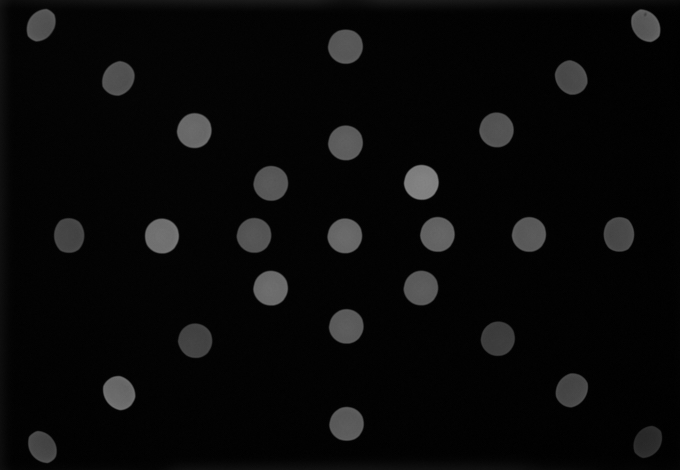
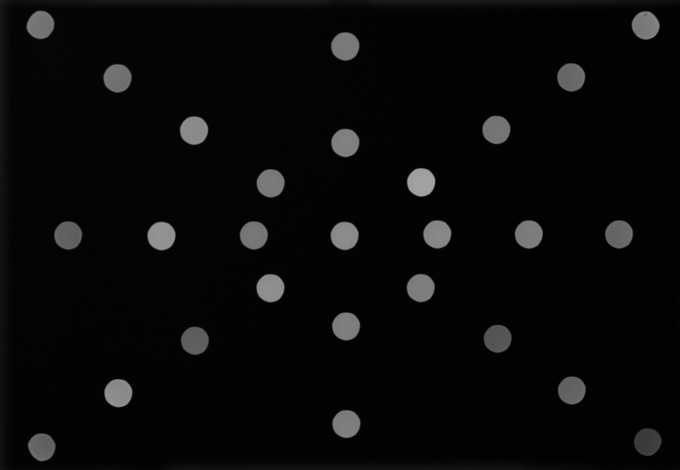

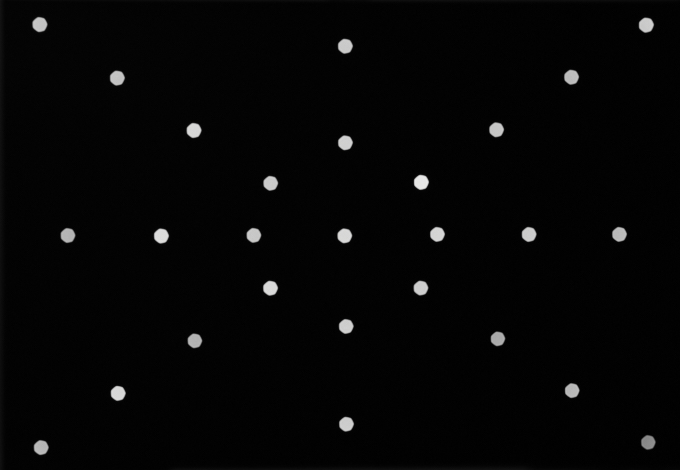
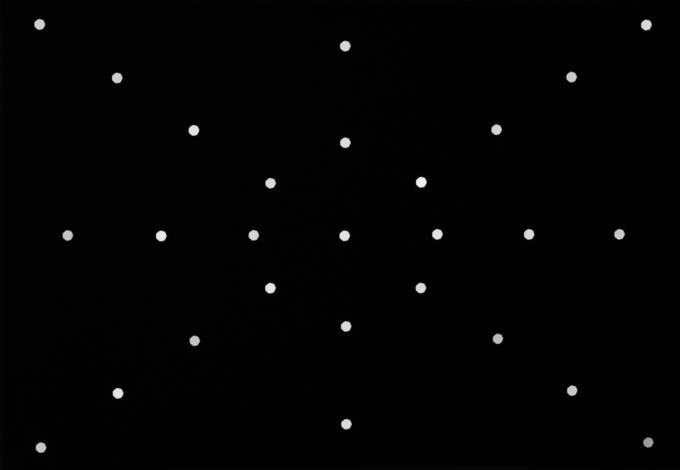
The general out-of-focus rendition is very smooth in the image background (shown to the left below), but bit more nervous in the foreground (to the right below), especially close to the transition zone from in-focus to out-of-focus areas.
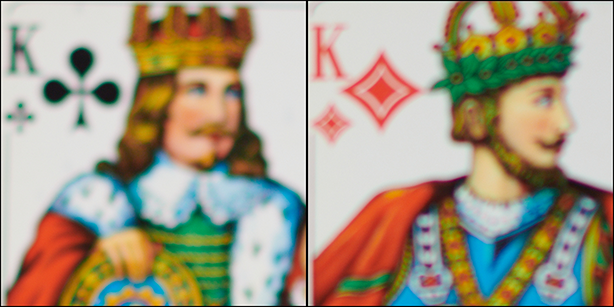
Bokeh Fringing / LoCA
Bokeh fringing (non-coinciding focal planes of the various colors, also referred to as longitudinal chromatic aberration, or LoCA for short) is an axial color fringing effect and a common issue with relatively fast glass. It’s visible as halos of different colors in out-of-focus areas – magenta (red + blue) in front of the focus point and green beyond.
Typical for most fast primes, the AF-S 85 shows noticeable bokeh fringing at large aperture settings, which can of course be reduced by stopping down.
In addition, these shots also show the slight focus shift when stopping down, which was mentioned in the MTF section.
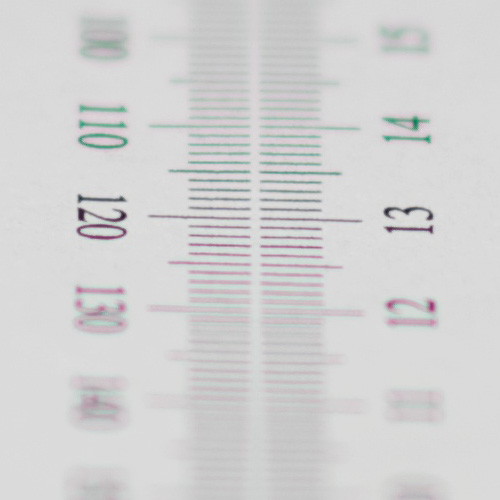

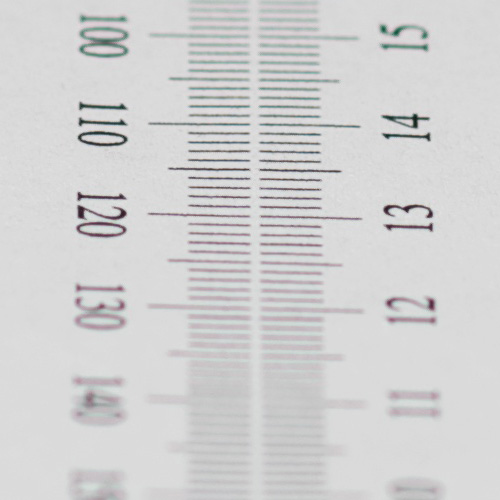
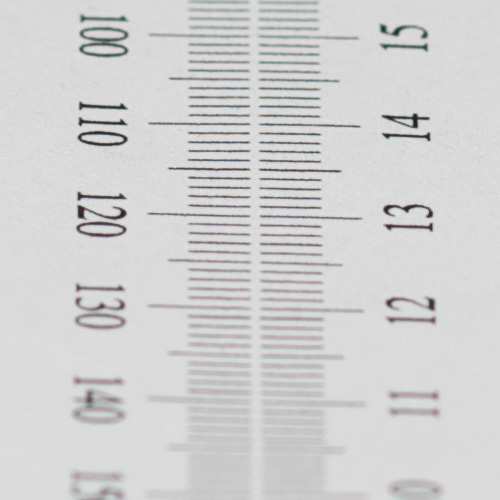
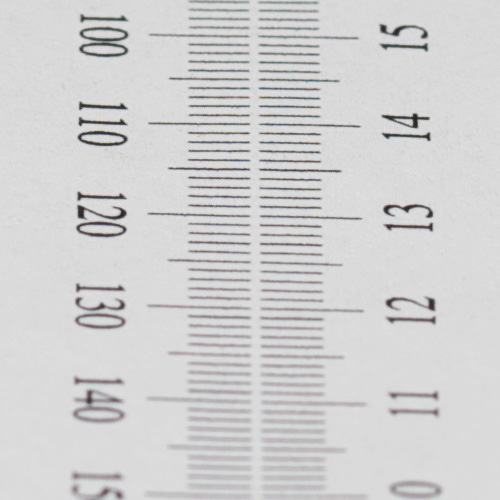
Sample Shots
The following sample shots were RAW-converted in CaptureOne with lens corrections disabled.
The Nikkor AF-S 85mm f/1.8 G is an excellent lens that performs on a very high level in almost every regard. Sharpness is on a very high level in the image center straight from the largest aperture, the borders and corners deliver very good resolution throughout the tested aperture range.
Typical for a fast prime there is pronounced vignetting wide open, which can easily be cured by stopping down. The same applies to Bokeh fringing. CAs and distortion are very well controlled though. The biggest surprise is probably the bokeh quality, which is not right up there on the benchmark level set by 85mm f/1.4 lenses, but quite close.
The build quality is on a high level and in line with other Nikon consumer prime offerings. Thanks to an AF-S drive autofocus action is virtually silent and quite fast for a portrait lens.
So, in summary, for most subjects the lens performs very similar to faster 85/1.4 lenses, but at a fraction of the price. Certainly highly recommended!
-
Optical Quality
-
Build Quality
-
Price/Performance


